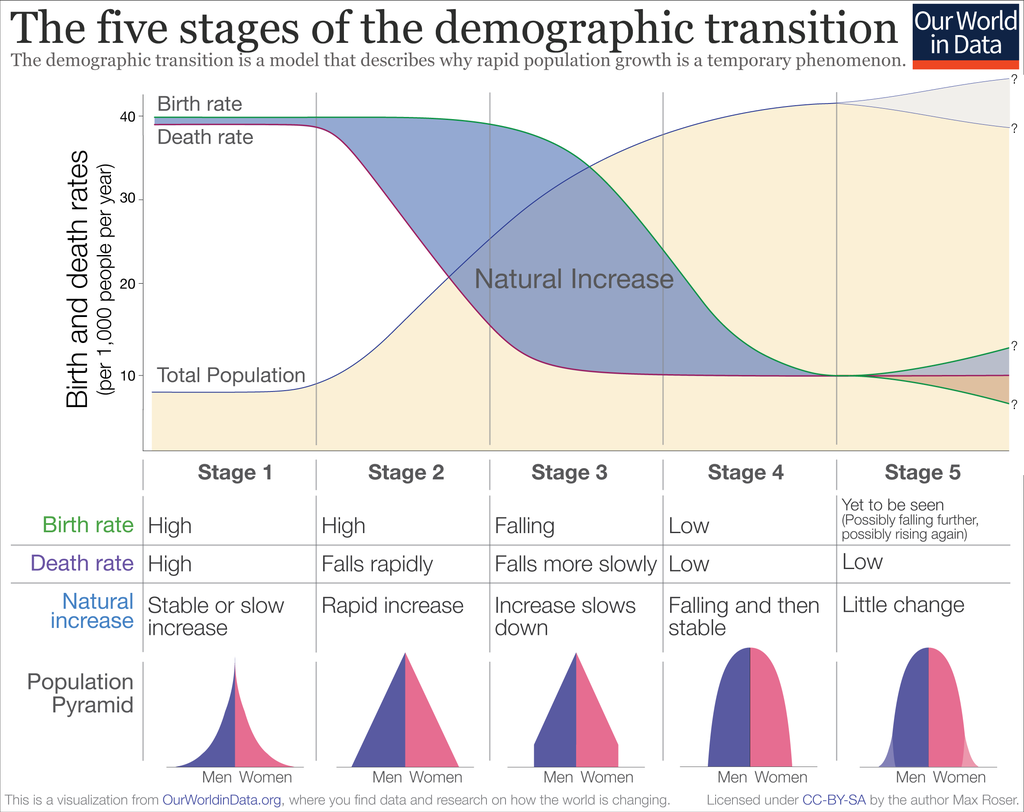
This is a glossary of the most common demographic (population-related) terms. Note that different organizations and researchers sometimes use slightly different methods to calculate some of these terms but their overall meaning is usually the same.
Demography
Demography is the scientific study of human populations — their size, composition, how they move from one place to another, and how they change through births and deaths. Understanding these patterns and trends can help policymakers, academics, and experts address population, health, and environment challenges.
Total Fertility Rate (TFR)
Total fertility rate (sometimes abbreviated to fertility rate) is an approximation of the number of children a woman would be expected to give birth to during her lifetime, based on the age-specific fertility rates of a given period.
Age-specific fertility rate is the annual number of births to women in a specific age group divided by the number of women in that age group.
TFR is calculated by adding the age-specific fertility rates for each age group (if data is grouped in five-year increments, the sum is multiplied by five).
Currently, the global fertility rate is 2.3, meaning women are having an average of 2.3 children worldwide. Fertility rates vary widely by country, ranging from only 0.8 children per woman in South Korea, to 6.7 in Niger.
Completed Fertility Rate
Completed fertility rate is used to compare the fertility rates of different generations, or cohorts, of women. It is the average number of children born to women at the end of their reproductive years, usually after age 44.
Replacement-Level Fertility
The replacement-level fertility rate is the fertility rate that would keep a population stable over time. The global replacement rate is 2.1 — two children ‘replace’ the parents, and the extra 0.1 accounts for children who don’t survive to adulthood. The lower the child mortality in a given population, the closer the replacement rate will be to 2.
Birth Rate
General fertility rate, often called birth rate, is the number of live births per 1,000 women ages 15-44 in a given period. Crude birth rate, also called total birth rate, is the number of live births per 1,000 total population (all ages and genders) in a given period.
Death Rate
Death rate is the number of deaths per 1,000 people over a given period. High death rates aren’t restricted to the poorest countries — populations with a high proportion of elderly people naturally have a higher death rate, and global health crises such as the Covid-19 pandemic increase death rates everywhere. Mortality is another term for death rate.
Maternal Mortality
Maternal mortality describes deaths due to complications from pregnancy or childbirth, including the year postpartum. It is usually expressed as a ratio of the number of deaths to 100,000 live births in a given population. Major causes of maternal mortality are hemorrhage, infection, pre-eclampsia and eclampsia, delivery complications, and unsafe abortion. Unsafe abortions account for 13% of maternal deaths globally and are much more prevalent in settings where safe abortion is illegal.
Child Mortality
Child mortality refers to the number of child deaths, expressed per 1,000 live births. Child mortality usually accounts for children aged five and younger (also called under-5 mortality), while infant mortality describes deaths of babies younger than 12 months. Countries with the highest fertility rates also tend to have the highest child mortality rates. Women living in low-income countries often don’t have the power or means to choose their family size, so are forced to have more children than they can safely provide for. In addition, high child mortality can be a driver of large family size, with couples trying to make up for the children they have lost or are likely to lose.
Natural Population Increase
Natural population increase, growth, or change is the number of deaths subtracted from the number of births in a given year. It describes how much a population has “naturally” increased or decreased (in the absence of migration).
Population Growth Rate
The population growth rate is the proportion by which a population changes every year. It is expressed in percent. If the growth rate is negative, it means the population is decreasing.
In 2022, the world population growth rate is 0.84%. The United Nations Population Division estimates that 2020 was the first year in history our population growth rate dropped below 1%.
Migration
Migration is the movement of people into or out of a geographic area, thus affecting local population growth. Specifically, migration measures permanent changes in residence between designated political or statistical areas, which can take place within or between countries. In-migration is called immigration, and out-migration is called emigration.
Climate Migrants
Climate or ‘environmental’ migrants are forced to leave their homes due to environmental deterioration. Drought, desertification, and sea level rise caused by the climate crisis are examples of environmental changes that can force people to seek new places to live.
Sex Ratio
The sex ratio is the sex composition of a population, expressed as the number of males for every 100 females. Sex ratios are driven by fertility, mortality, and migration.
China has an infamously skewed sex ratio as a result of sex-selective abortion of female fetuses during the one-child policy, driven by couples’ preference for male children (a result of societal gender inequality).
Carrying Capacity
Carrying capacity is an ecological concept that attempts to determine the maximum number of individuals of a species a given area can support indefinitely. Several researchers have attempted to determine the global carrying capacity for human beings, but estimates vary widely because overall human impact is heavily dependent on consumption habits. A smaller population with a very large per person footprint can be as unsustainable as a larger population with a smaller per person footprint.
IPAT
The IPAT equation, I = P x A x T, is a mathematical formula developed by Zero Population Growth (ZPG) founder Paul Ehrlich and colleagues in 1970. It is a way to measure our impact on the planet, where I is impact, P is population size, A is affluence, and T is technology. The larger the population and the higher the affluence (an approximation of consumption), the larger the impact on our environment. The technology factor can be either amplifying (e.g. industrial agriculture) or reducing (e.g. renewable energy).
Unintended Pregnancy
An unintended pregnancy is a pregnancy that is either mistimed or unwanted at the time of conception. Approximately half of all pregnancies worldwide are unintended and 60% of these end in abortion.
Unmet Need for Family Planning
Having an unmet need for family planning describes the desire to avoid pregnancy despite not using contraception. Reasons for non-use vary but are now predominately related to myths and misconceptions about birth control methods, as well as opposition from others — including male partners — rather than lack of access. The latest UN figures estimate that 257 million women globally have an unmet need for modern contraception, of which 218 million live in low- and middle-income countries.
SRHR
SRHR is short for Sexual and Reproductive Health and Rights. It describes the essential human right to bodily autonomy and access to safe healthcare and information related to reproductive decisions, including family planning (contraception) and abortion. SRHR is also a powerful development lever and solution to our environmental crises; when people are empowered to make their own reproductive decisions, their quality of life improves and they tend to choose smaller families, reducing population pressure.
Sustainable Development Goals (SDGs)
The United Nations Sustainable Development Goals, or SDGs for short, are a set of 17 ambitious goals that aim to achieve a good quality of life for all on a healthy planet by 2030. The SDGs were created in 2015 to replace the (failed) Millienium Development Goals, and range from achieving zero hunger and poverty, to universal healthcare and gender equality, to ending climate change and biodiversity loss. Unfortunately, we are on track to miss them if we don’t accelerate progress.
Demographic Transition
Demographic transition is a crucial phase in a country’s development, marked by a declining death rate (due to improved healthcare), followed by a declining fertility rate as people gain the ability to choose smaller families. Initially, the lower death rate and still high fertility rate result in rapid population growth, but once the fertility rate begins to decline also, population growth slows and eventually stops.

Demographic Dividend
The demographic dividend refers to the acceleration in a country’s economic growth resulting from the demographic transition, which reduces the ratio of young dependents to the working-age population. With a higher proportion of people entering the work force, the country’s economy gets a boost. Countries with persistently high fertility rates are unable to reap the demographic dividend due to their high proportion of dependent children.
Dependency Ratio
The dependency ratio is the ratio of dependents — children and older people — to the working-age population (usually defined as 15-64 years old). A high dependency ratio is associated with slower economic growth.
Population Ageing
Population ageing is a result of increasing longevity and a decreasing fertility rate, which increases the proportion of older people in a population. Every developed country is ageing, which concerns mainstream economists who believe economies should be growing continuously. However, it’s a prerequisite to population stabilization and there are many measures governments can take to reduce the negative impacts of population ageing, such as investing in preventive healthcare.
Population/Demographic Momentum
Population or demographic momentum refers to the tendency for changes in population growth to lag behind changes in fertility rates. A population that formerly had a high fertility rate will have a large number of people of reproductive age, so will continue to have high population growth for several years even though its fertility rate may have already reached replacement level. Many high-income countries with fertility rates well below 2 are still experiencing natural population increase as a result of population momentum.
Population Pyramid
Population pyramids describe the age and sex structure of populations. They are stacked bar charts, with each bar representing an age cohort (young at the bottom and old at the top), and with males on the left and females on the right. Developing countries with a high proportion of young dependents tend to be pyramid shaped, while countries that have completed the demographic transition are more cylindrical (see demographic transition chart above for examples).
Population Projections
Population projections estimate the size and age structure of populations in the future. Projections are not predictions and can vary widely based on different variables that affect fertility, birth and death rates. Population Connection uses the United Nations projections, the World Population Prospects, which are considered to be among the most authoritative and are revised every few years based on the best available data and models.
